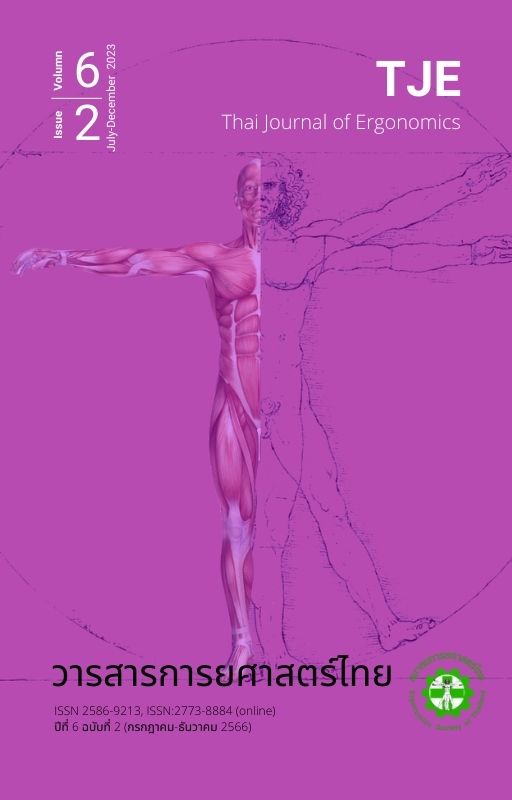การทบทวนแผนที่สมองวัดความสามารถอิงการประเมินประสาทการยศาสตร์สำหรับคนไทย
Main Article Content
บทคัดย่อ
การทดสอบหนึ่งที่แปลกใหม่เรียก “แผนที่สมองวัดความสามารถ หรือ brain mapping performance (BMP)” ถูกพัฒนาโดยนักกิจกรรมบำบัดจิตสังคมในการเรียนรู้ที่ชัดแจ้งตลอดช่วงชีวิต สำหรับหลายคนที่ไม่ยอมเชื่อในประโยชน์จากการเกิดขึ้นของประสาทการยศาสตร์ก็ยังคงเป็นเรื่องท้าทายในการประเมินความพร้อมของงานจริง แต่ละบุคคลจะมีระดับสมรรถนะของสมองภายในสำหรับแผนที่สมองวัดความสามารถด้านสภาวะผู้นำที่อธิบายได้โดยการกระตุ้นจรณทักษะ หรือ soft skills เน้นการบรรลุถึงการเข้าร่วมแสดงความเครียดบวก และความร่วมรู้สึกเอาใจใส่ผู้อื่น บทความนี้มุ่งหมายให้แนวทางเข้าสังคมและเสริมสร้างคุณธรรมผ่านเซลล์กระจกเงาโดยการแปลผลของแผนที่สมองวัดความสามารถอิงการประเมินประสาทการยศาสตร์สำหรับคนไทย บทความนี้มีส่วนช่วยเป็นหนึ่งแนวทางการบูรณาการคุณธรรมผ่านเซลล์กระจกเงาที่ต่อมาได้เปรียบเทียบผลก่อน และหลังของแผนที่สมองวัดความสามารถอิงการประเมินประสาทการยศาสตร์เพื่อพัฒนาความพร้อมของงานจริงและภาวะผู้นำของคนไทย อันจะนำไปสู่การเชื่อมโยงองค์กรแห่งสุขภาวะ และองค์กรแห่งการเรียนรู้อย่างแท้จริง
Article Details

This work is licensed under a Creative Commons Attribution-NonCommercial-NoDerivatives 4.0 International License.
References
Parasuraman R, Wilson GF. Putting the brain to work: neuroergonomics past, present, and future. Hum Factors 2008;50(3):468-74. doi: 10.1518/001872008X288349
Mijović P, Ković V, De Vos M, Mačužić I, Jeremić B, Gligorijević I. Benefits of instructed responding in manual assembly tasks: an ERP approach. Front Hum Neurosci. 2016;10. doi: 10.3389/fnhum.2016.00171
Mijović P, Ković V, De Vos M, Mačužić I, Todorović P, Jeremić B, et al. Towards continuous and real-time attention monitoring at work: reaction time versus brain response. Ergonomics. 2017;60(2):241-254. https://doi.org/10.1080/00140139.2016.1142121
Alyan E, Saad NM, Kamel N, Rahman MA. Workplace design-related stress effects on prefrontal cortex connectivity and neurovascular coupling. Appl Ergon. 2021;96:103497. https://doi.org/10.1016/j.apergo.2021.103497.
Ismail LE, Karwowski W. Applications of EEG indices for the quantification of human cognitive performance: A systematic review and bibliometric analysis. PLos One. 2020;15(12):e0242857. https://doi.org/10.1371/journal.pone.0242857
Wascher E, Reiser JA-O, Rinkenauer G, Larrá M, Dreger FA, Schneider D, et al. Neuroergonomics on the go: an evaluation of the potential of mobile EEG for workplace assessment and design. Hum Factors 2023;65(1):86-106.
Dehais F, Lafont A, Roy R, Fairclough S. A neuroergonomics approach to mental workload, engagement and human performance. Front Neurosci 2020;14.268.
DePaul GA. Nine practices of 21st century leadership: a guide for inspiring creativity, innovation, and engagement. United States: Taylor & Francis; 2023.
Nardi D. Neuroscience of personality: brain savvy insights for all types of people. United States: Radiance House; 2011.
Ohreen D. A critical review of mirror neurons in business ethics : they don’t reflect as much as you think. J Appl Ethics Philos 2021;12:8-18. https://doi.org/10.14943/jaep.12.8
Thanyawatpornkul R, Khemthong S, Chatthong W. Scoping review on brain mapping leadership and talent engagement. Indian J Public Health Res Dev 2022;13(4):199-204. https://doi.org/10.37506/ijphrd.v14i4.18592
Plachy RJ, Smunt TL. Rethinking managership, leadership, followership, and partnership. Bus Horiz 2022;65(4):401-11. https://doi.org/10.1016/j.bushor.2021.04.004
Rodríguez Y, Pérez E, Robertson MM. Ergonomic maturity model: a tool for integrating ergonomics/human factors into organizations. Work 2022;73:S279-S92. doi: 10.3233/WOR-211142
Amadi EO, Wariowei RE. The Impact of office ergonomics on the job performance of the educational manager. BW Academic Journal 2022;1(1):10.
Kopańska M, Ochojska D, Dejnowicz-Velitchkov A, Banaś-Ząbczyk A. Quantitative electroencephalography (QEEG) as an Innovative diagnostic tool in mental disorders. Int J Environ Res Public Health. 2022;19(4):2465. https://doi.org/10.3390/ijerph19042465
Chatthong W, Khemthong S, Wongsawat Y. Brain mapping performance as an occupational therapy assessment aid in attention deficit hyperactivity disorder. Am J Occup Ther 2020;74(2):1-7. doi: 10.5014/ajot.2020.035477.
Chatthong W, Khemthong S, Wongsawat Y. Neuropsychological classification based on brain mapping performance in Thai children with and without ADHD. Appl Neuropsychol Child 2022;11(1):18-24. doi: 10.1080/21622965.2020.1729155
Ahmed S, Qamar F, Soomro SA. Ergonomic work from home and occupational health problems amid COVID-19. Hum Syst Manag 2022;41:535-51. doi: 10.3233/HSM-211548
Cetrano G, Tedeschi F, Rabbi L, Gosetti G, Lora A, Lamonaca D, et al. How are compassion fatigue, burnout, and compassion satisfaction affected by quality of working life? Findings from a survey of mental health staff in Italy. BMC Health Serv Res 2017;17(1):755. https://doi.org/10.1186/s12913-017-2726-x
Martinez W, Benerradi J, Midha S, Maior HA, Wilson ML, editors. Understanding the Ethical Concerns for Neurotechnology in the Future of Work; 2022.
Ghani A, Kaliappen N, Jermsittiparsert K. Enhancing Malaysian SME employee work engagement: the mediating role of job crafting in the presence of task complexity, self-efficacy and autonomy. Int J Innov Creativity Chang 2019;6(11):1-18.
Moore JR, Maxey EC, Waite AM, Wendover JD. Inclusive organizations: developmental reciprocity through authentic leader-employee relationships. J Manag Dev 2020;39(9):1029-39. https://doi.org/10.1108/JMD-05-2019-0211
Pater R. MINDING THE GAP: Overcoming the strains (& Sprains) of psychosocial contributors. Prof Saf. 2022;67(6):14-9.
Chatthong W, Khemthong S, Wongsawat Y. A design thinking model based on quantitative electroencephalography in social emotional learning for attention deficit hyperactivity disorder. Mind Brain Educ 2020;14(2):104-13. https://doi.org/10.1111/mbe.12235
Mehta R, Parasuraman R. Neuroergonomics: a review of applications to physical and cognitive work. Front Hum Neurosci 2013;7:889. doi: 10.3389/fnhum.2013.00889
Sarter N, Sarter M. Neuroergonomics: opportunities and challenges of merging cognitive neuroscience with cognitive ergonomics. Theor Issues Ergon Sci 2003;4(1-2):142-50. https://doi.org/10.1080/1463922021000020882
Powers JC, Bieliaieva K, Wu S, Nam CS. The human factors and ergonomics of P300-based brain-computer interfaces. Brain Sci. 2015;5(3):318-56. doi: 10.3390/brainsci5030318
Nam CS. Brain–computer interface (BCI) and ergonomics. Ergonomics. 2012;55(5):513-5. doi: 10.1080/00140139.2012.676675
Gehrke L, Lopes P, Klug M, Akman S, Gramann K. Neural sources of prediction errors detect unrealistic VR interactions. J Neural Eng 2022;19(3). doi: 10.1088/1741-2552/ac69bc
Borghetti L, Rhodes LJ, Morris MB, editors. Fatigue leads to dynamic shift in fronto-parietal sustained attention network 2022;66(1):606-610. https://doi.org/10.1177/1071181322661056
Young C, Hamilton-Wright A, Oliver ML, Gordon KD. Predicting wrist posture during occupational tasks using inertial sensors and convolutional neural networks. Sensors. 2023;23(2):942. https://doi.org/10.3390/s23020942
Ekstrom MJC. Mirror neurons and empathy: a biomarker for the complementary system; 2021.
Caiazzo C, Savković M, Djapan M, Vukićević A, Jovičić M, Mačužić I. Framework of modular industrial workstations for neuroergonomics experiments in a collaborative environment; 2022. doi: 10.3850/978-981-18-5183-4_J01-07-285-cd

